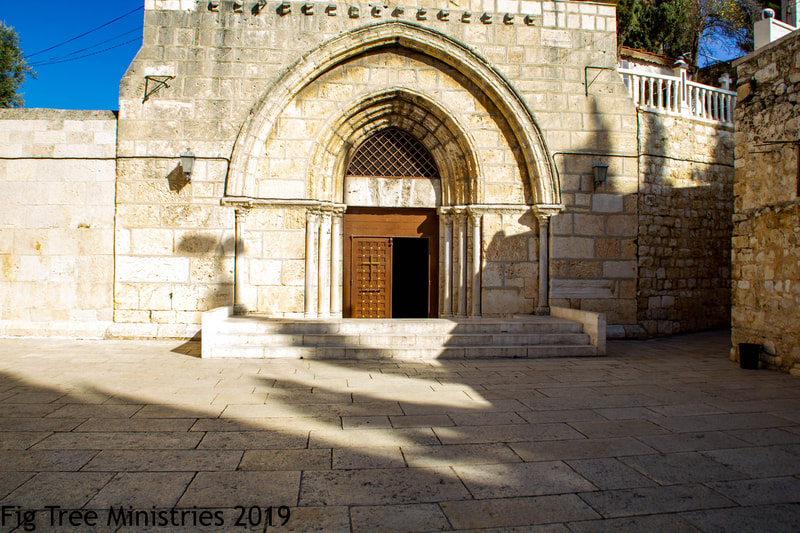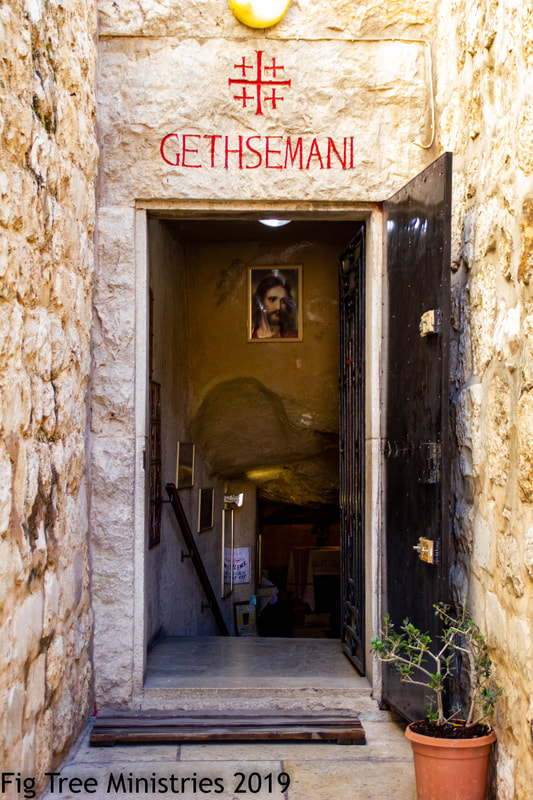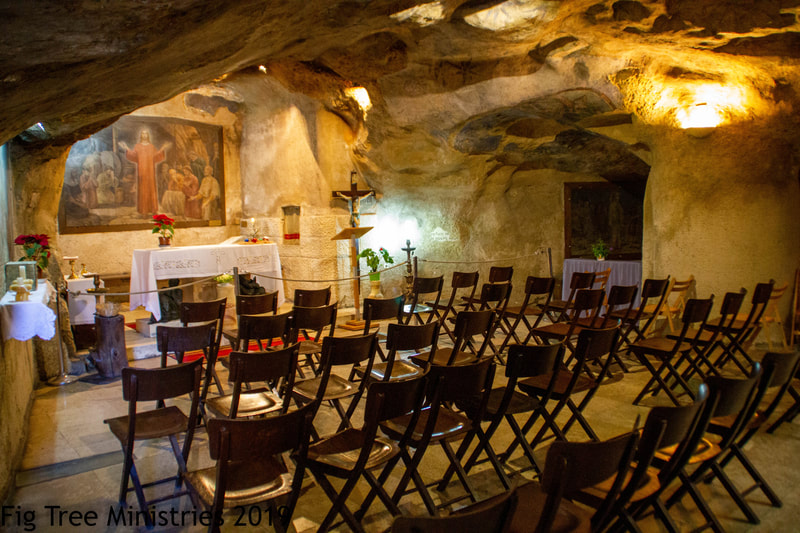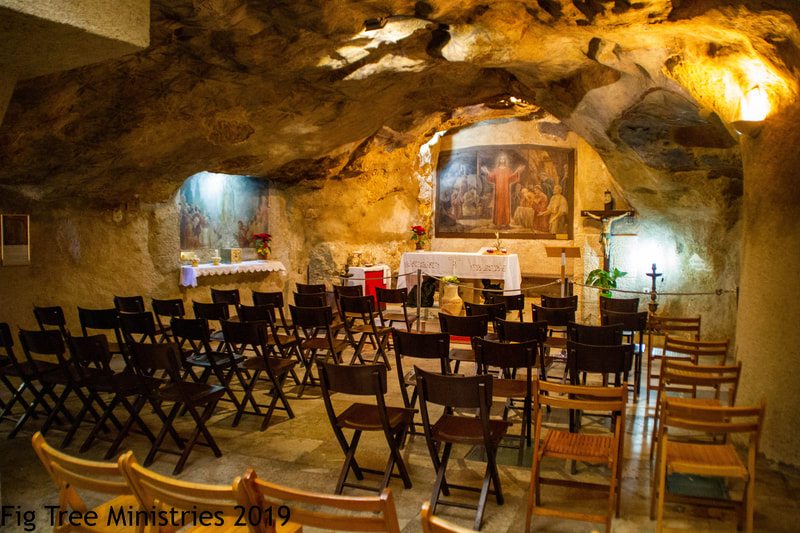Gethsemane
In Hebrew the phrase is Gat-Shemanim.
A Gat is a 'press.' Goliath was from the Philistine city of Gat (we say Gath)- an area of Israel teaming with presses.
Shemanim is the word for 'oils.'
So the word Gat-Shemanim is a press for oils or an olive press.
A Gat-Shemanim is ideally located in a cave which helps keep the temperature under control during the processing of the olive oil. .
Across the Kidron Valley, east of Jerusalem, is the Mount of Olives. There is a garden with olive trees. John writes, "On the other side there was a garden, and he and his disciples went into it."
There is also a gat-shemanim - an olive press. Matthew writes, "Then Jesus went with his disciples to a place called Gethsemane..."
Somewhere in our Christian tradition, we have combined the two, and we call the location "the garden of Gethsemane" -- even though the scripture does not put these two words together.
The Gethsemane (gat-shemanim) is in a cave just north of the Church of All Nations which has an olive tree grove. This olive tree grove has traditionally been called 'the garden of Gethsemane.'
Passover, the holiday which Jesus was crucified, is in the early spring (14th of Nisan). During that time of year it was not the season for pressing olives. The Gethsemane would not be in use. What do you do with an empty cave during the pilgrimage festival of Passover/Unleavened Bread? You allow travelers to use it as shelter.
Scholars believe that Jesus and his disciples stayed inside the cave which would have been used as an olive press at other times of the year.
Joan Taylor has an excellent article in Biblical Archaeology Review titled The Garden of Gethsemane: Not the Place of Jesus' Arrest in which she provides a detailed analysis.
The image of the olive press - and the weights of the massive stones which press down to squeeze the precious oil from the olive pulp - provides a stark juxtaposition to Jesus in the garden the night prior to his death.
Jesus prayed for his father in heaven to "take this cup" as the realization of what he was going to have to do sank in.
It wasn't simply the weight of the olive press stones that he would have to endure, but the weight of the sins of the world!
As that unbearable weight began to press down on him Luke tells us that the sweat was squeezed out of him and began to fall like great drops of blood (Luke 22:44).
Unfortunately, most travelers head to the olive grove at the Church of All Nations and largely ignore the actual Gat-Shemanim.
Below are pictures of the cave today which has been turned into a chapel.
(Taylor, Joan E. “The Garden of Gethsemane: Not the Place of Jesus’ Arrest,” Biblical Archaeology
Review 21.4 (Jul/Aug 1995): 2631, 3435, 62).
A Gat is a 'press.' Goliath was from the Philistine city of Gat (we say Gath)- an area of Israel teaming with presses.
Shemanim is the word for 'oils.'
So the word Gat-Shemanim is a press for oils or an olive press.
A Gat-Shemanim is ideally located in a cave which helps keep the temperature under control during the processing of the olive oil. .
Across the Kidron Valley, east of Jerusalem, is the Mount of Olives. There is a garden with olive trees. John writes, "On the other side there was a garden, and he and his disciples went into it."
There is also a gat-shemanim - an olive press. Matthew writes, "Then Jesus went with his disciples to a place called Gethsemane..."
Somewhere in our Christian tradition, we have combined the two, and we call the location "the garden of Gethsemane" -- even though the scripture does not put these two words together.
The Gethsemane (gat-shemanim) is in a cave just north of the Church of All Nations which has an olive tree grove. This olive tree grove has traditionally been called 'the garden of Gethsemane.'
Passover, the holiday which Jesus was crucified, is in the early spring (14th of Nisan). During that time of year it was not the season for pressing olives. The Gethsemane would not be in use. What do you do with an empty cave during the pilgrimage festival of Passover/Unleavened Bread? You allow travelers to use it as shelter.
Scholars believe that Jesus and his disciples stayed inside the cave which would have been used as an olive press at other times of the year.
Joan Taylor has an excellent article in Biblical Archaeology Review titled The Garden of Gethsemane: Not the Place of Jesus' Arrest in which she provides a detailed analysis.
The image of the olive press - and the weights of the massive stones which press down to squeeze the precious oil from the olive pulp - provides a stark juxtaposition to Jesus in the garden the night prior to his death.
Jesus prayed for his father in heaven to "take this cup" as the realization of what he was going to have to do sank in.
It wasn't simply the weight of the olive press stones that he would have to endure, but the weight of the sins of the world!
As that unbearable weight began to press down on him Luke tells us that the sweat was squeezed out of him and began to fall like great drops of blood (Luke 22:44).
Unfortunately, most travelers head to the olive grove at the Church of All Nations and largely ignore the actual Gat-Shemanim.
Below are pictures of the cave today which has been turned into a chapel.
(Taylor, Joan E. “The Garden of Gethsemane: Not the Place of Jesus’ Arrest,” Biblical Archaeology
Review 21.4 (Jul/Aug 1995): 2631, 3435, 62).
Gethsemane Photos
AddressP.O. Box 50881
Nashville, TN 37205 |
Email
|
|
|
|
Fig Tree Ministries is a 501(c)(3) CA nonprofit dedicated to increasing Biblical education within the body of Christ.
Our ongoing operations are funded through donations from our amazing supporters. Consider supporting Fig Tree Ministries today! |
Connect with us! |




